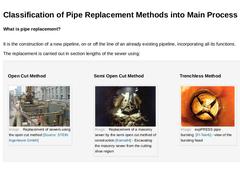
|
What is pipe replacement?
It is the construction of a new pipeline, on or off the line of an already existing pipeline, incorporating all its functions. The replacement is carried out in section lengths of the sewer using: Open Cut Method (Image: Replacement of sewers using the open cut method) Semi Open Cut Method (Image: Replacement of a masonry sewer by the semi open cut method of construction [Karna94] - Excavating the masonry sewer from the cutting … |
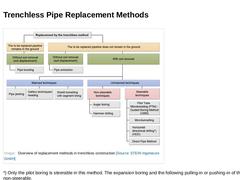
|
(Image: Overview of replacement methods in trenchless construction) *) Only the pilot boring is steerable in this method. The expansion boring and the following pulling-in or pushing-in of the pipes are non-steerable. |
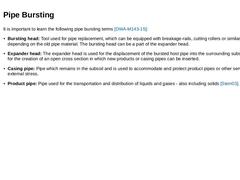
|
It is important to learn the following pipe bursting terms [DWA-M143-15]: -
Bursting head: Tool used for pipe replacement, which can be equipped with breakage-rails, cutting rollers or similar devices - depending on the old pipe material. The bursting head can be a part of the expander head.
-
Expander head: The expander head is used for the displacement of the bursted host pipe into the surrounding subsoil, and also for the creation of an open cross …
|
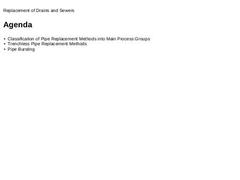
|
|
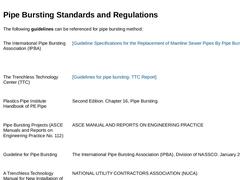
|
The following guidelines can be referenced for pipe bursting method: The International Pipe Bursting Association (IPBA) [Guideline Specifications for the Replacement of Mainline Sewer Pipes By Pipe Bursting ] The Trenchless Technology Center (TTC) [Guidelines for pipe bursting- TTC Report] Plastics Pipe Institute Handbook of PE Pipe Second Edition. Chapter 16, Pipe Bursting. Pipe Bursting Projects (ASCE Manuals and Reports on Engineering Practice No. 112) |
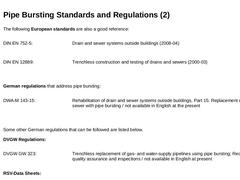
|
The following European standards are also a good reference: Drain and sewer systems outside buildings (2008-04) Trenchless construction and testing of drains and sewers (2000-03) German regulations that address pipe bursting: Rehabilitation of drain and sewer systems outside buildings, Part 15: Replacement of drains and sewer with pipe bursting / not available in English at the present Some other German regulations … |
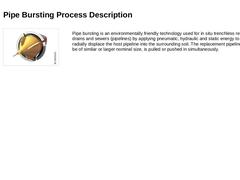
|
(Image: Replacement by trenchless method) Pipe bursting is an environmentally friendly technology used for in situ trenchless replacement of drains and sewers (pipelines) by applying pneumatic, hydraulic and static energy to fracture and radially displace the host pipeline into the surrounding soil. The replacement pipeline, which can be of similar or larger nominal size, is pulled or pushed in simultaneously. |
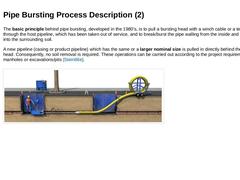
|
The basic principle behind pipe bursting, developed in the 1980's, is to pull a bursting head with a winch cable or a tension rod through the host pipeline, which has been taken out of service, and to break/burst the pipe walling from the inside and force it radially into the surrounding soil. A new pipeline (casing or product pipeline) which has the same or a larger nominal size is pulled in directly behind the bursting head. Consequently, no soil … |
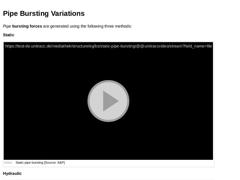
|
Pipe bursting forces are generated using the following three methods: Static (Video: Static pipe bursting) Hydraulic (Video: Hydraulic pipe bursting) Pneumatic (Video: Pneumatic pipe bursting) |
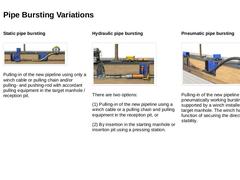
|
Static pipe bursting
(Image: Illustration of the static pipe bursting - pulling-in of a continuous pipe) Pulling-in of the new pipeline using only a winch cable or pulling chain and/or pulling- and pushing-rod with accordant pulling equipment in the target manhole / reception pit. Hydraulic pipe bursting
(Image: Hydraulic pipe bursting process - pushing-in of discrete pipes) There are two options: (1) Pulling-in of the new pipeline using a winch cable … |
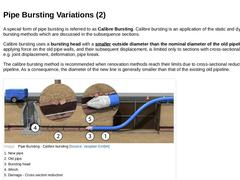
|
A special form of pipe bursting is referred to as Calibre Bursting. Calibre bursting is an application of the static and dynamic pipe bursting methods which are discussed in the subsequence sections. Calibre bursting uses a bursting head with a smaller outside diameter than the nominal diameter of the old pipeline. Thus, applying force on the old pipe walls, and their subsequent displacement, is limited only to sections with cross-sectional reductions … |
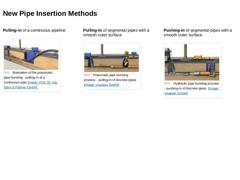
|
Pulling-in of a continuous pipeline
(Image: Illustration of the pneumatic pipe bursting - pulling-in of a continuous pipe) Pulling-in of segmental pipes with a smooth outer surface (Image: Pneumatic pipe bursting process - pulling-in of discrete pipes) Pushing-in of segmental pipes with a smooth outer surface (Image: Hydraulic pipe bursting process - pushing-in of discrete pipes) |
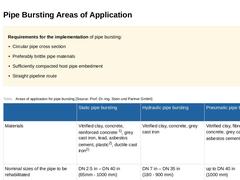
|
Requirements for the implementation of pipe bursting: -
Circular pipe cross section
-
Preferably brittle pipe materials
-
Sufficiently compacted host pipe embedment
-
Straight pipeline route
(Table: Areas of application for pipe bursting) |
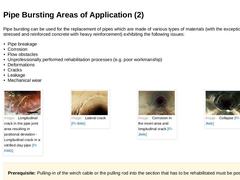
|
Pipe bursting can be used for the replacement of pipes which are made of various types of materials (with the exception of pre-stressed and reinforced concrete with heavy reinforcement) exhibiting the following issues: -
Pipe breakage
-
Corrosion
-
Flow obstacles
-
Unprofessionally performed rehabilitation processes (e.g. poor workmanship)
-
Deformations
-
Cracks
-
Leakage
-
Mechanical wear
(Image: Longitudinal crack in the pipe joint area resulting in positional … |
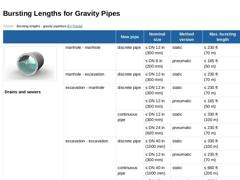
|
(Table: Bursting lengths - gravity pipelines [FI-Tracta]) |
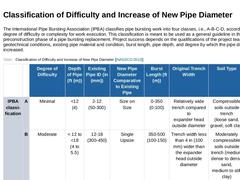
|
The International Pipe Bursting Association (IPBA) classifies pipe bursting work into four classes, i.e., A-B-C-D, according to the degree of difficulty or complexity for work execution. This classification is meant to be used as a general guideline in the design and preconstruction phase of a pipe bursting replacement. Project success depends on the qualifications of the project team, geotechnical conditions, existing pipe material and condition, … |
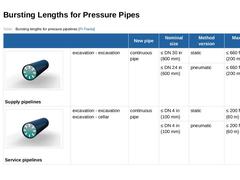
|
(Table: Bursting lengths for pressure pipelines [FI-Tracta]) |
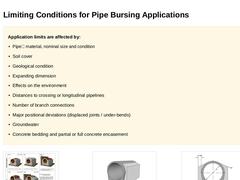
|
Application limits are affected by: -
Pipe– material, nominal size and condition
-
Soil cover
-
Geological condition
-
Expanding dimension
-
Effects on the environment
-
Distances to crossing or longitudinal pipelines
-
Number of branch connections
-
Major positional deviations (displaced joints / under-bends)
-
Groundwater
-
Concrete bedding and partial or full concrete encasement
(Image: Encasement and special supports of vitrified clay pipes with concrete … |
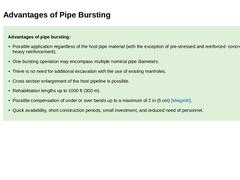
|
Advantages of pipe bursting: -
Possible application regardless of the host pipe material (with the exception of pre-stressed and reinforced concrete with heavy reinforcement).
-
One bursting operation may encompass multiple nominal pipe diameters.
-
There is no need for additional excavation with the use of existing manholes.
-
Cross section enlargement of the host pipeline is possible.
-
Rehabilitation lengths up to 1000 ft (300 m).
-
Possible compensation …
|
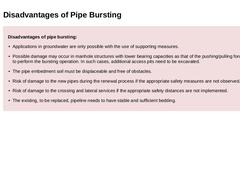
|
Disadvantages of pipe bursting: -
Applications in groundwater are only possible with the use of supporting measures.
-
Possible damage may occur in manhole structures with lower bearing capacities as that of the pushing/pulling forces needed to perform the bursting operation. In such cases, additional access pits need to be excavated.
-
The pipe embedment soil must be displaceable and free of obstacles.
-
Risk of damage to the new pipes during the renewal …
|
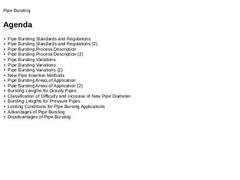
|
|
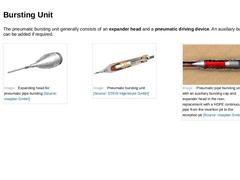
|
The pneumatic bursting unit generally consists of an expander head and a pneumatic driving device. An auxiliary bursting cap can be added if required. (Image: Expanding head for pneumatic pipe bursting) (Image: Pneumatic bursting unit) (Image: Pneumatic pipe bursting unit with an auxiliary bursting cap and expander head in the rear; replacement with a HDPE continuous pipe from the insertion pit to the reception pit) |
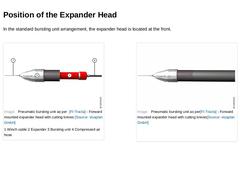
|
In the standard bursting unit arrangement, the expander head is located at the front. (Image: Pneumatic bursting unit as per [FI-Tracta] - Forward mounted expander head with cutting knives) (Image: Pneumatic bursting unit as per [FI-Tracta] - Forward mounted expander head with cutting knives) |
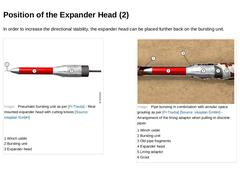
|
In order to increase the directional stability, the expander head can be placed further back on the bursting unit. (Image: Pneumatic bursting unit as per [FI-Tracta] - Rear mounted expander head with cutting knives) (Image: Pipe bursting in combination with annular space grouting as per [FI-Tracta] - Arrangement of the lining adaptor when pulling-in discrete pipes) |
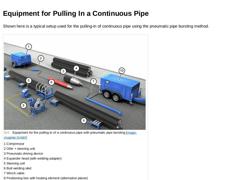
|
Shown here is a typical setup used for the pulling-in of continuous pipe using the pneumatic pipe bursting method. (Image: Equipment for the pulling-in of a continuous pipe with pneumatic pipe bursting) |